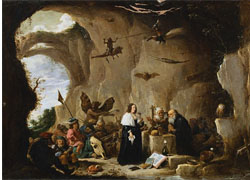Submitted by: Valerie Kramer, Theresa Steele, James Harvey Stone
School: Hermitage High School
Summary
Students in three different subject areas at two different schools read Plato’s Allegory of the Cave. Teachers and students discuss the historic background and basic philosophical concepts of the literature. Each class watches six videos (selected by the teacher) for the purpose of exploring the literature through animation, sound, film, etc. Teachers set up an online poll on dotvoting.org where students vote for the video that best translates the literature into the medium of film. The video with the most votes will appear on a student generated webpage about the allegory. Students from all the classes use the same voting venue (dotvoting.org). Teachers share results with students, and introduce them to the blog created for the project. Then students introduce themselves and their course of study on the blog so that all learners can communicate with each other online from their classroom or from home. Following the individual post, students group themselves based on designated, subject-specific topics. Student groups consider how their topic relates to the literature. Each group posts a response on the blog. In a final reflective post, students individually consider and share how the concepts, philosophy, and lessons from The Allegory of the Cave are relative to their lives and/or the time in which we live. As a final group activity, students publish the selected video and posts to a website for viewing by a larger audience.
TIPC Ratings
Students locate resources to support their group blog responses about subject area topics. Students justify their responses by selecting appropriate sources using advanced search techniques (which had been modeled by teachers in previous lessons).
Students collaborate across subject areas, grade levels, and school buildings. The blog allows students and teachers to share learning insights online and accommodates the need for teachers to instruct at varying paces on different days. Students form their own groups and collaborate on research and formulate a shared blog response. Students also use the blog to reflect on the relevance of Allegory of the Cave to their lives. Students contribute to the website for this lesson by inviting viewers to share opinions on the literature (Allegory of the Cave). The website will remain active through this school year.
Student groups analyze the videos and determine which one would best help others understand the Allegory of the Cave. Also, students thoughtfully consider the impact of the allegory on their lives 3000 years after its creation. They reflect on the allegory and its relationship to their current lives, modernity, and the group topics (art, music, adult learners, etc.). Further, they reflect (online) with students in other content areas and at another school to determine how others understand the meaning of the allegory.
By sharing their insights about the allegory via the blog, students took individual and group risks due to the personal nature of their sharing. In addition, students took further risks in being able to work with and share with learners in different courses, grade levels, and buildings. Students creatively apply the allegory on multiple levels (subject matter, topic, personal).
Download Files
- Lesson Plan
- Rubrics
- The Cave Blog for Student Project
- The Cave Website for Student Project





